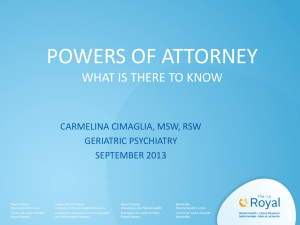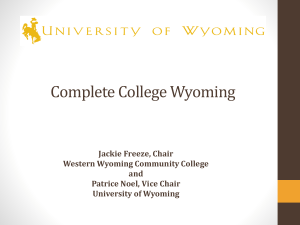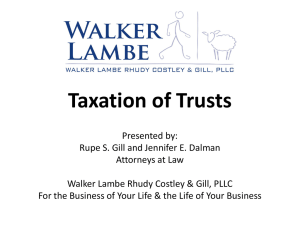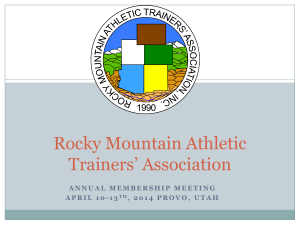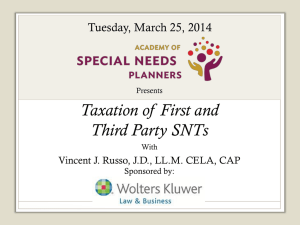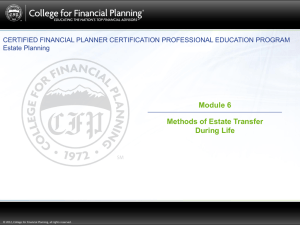Fundamentals of United States Taxation of Foreign Trusts, Grantors
advertisement
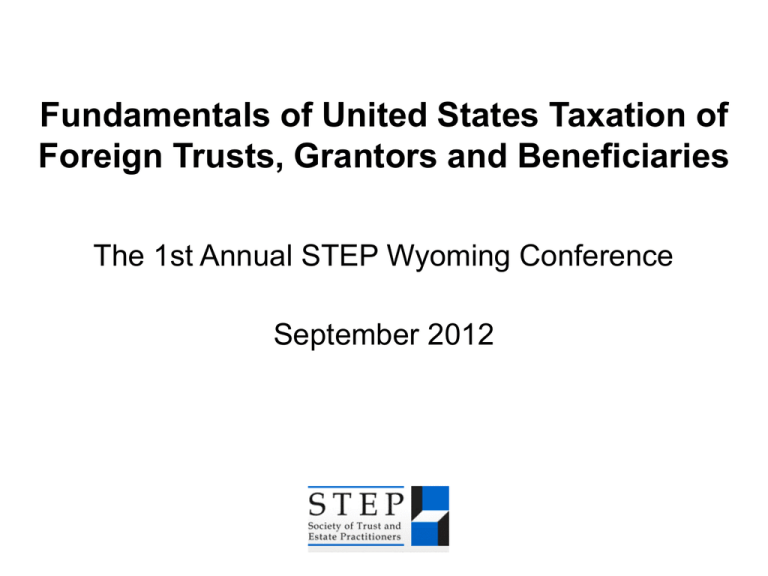
Fundamentals of United States Taxation of Foreign Trusts, Grantors and Beneficiaries The 1st Annual STEP Wyoming Conference September 2012 The Panel Michael J. A. Karlin, Karlin & Peebles, LLP, Beverly Hills, CA G. Warren Whitaker, Day Pitney LLP, New York, NY 9/22/2012 STEP Wyoming Conference 2 Overview 1. 2. 3. 4. Classifying trusts for income tax purposes Income tax treatment of grantors, trusts and beneficiaries U.S. transfer taxes Planning scenarios 9/22/2012 STEP Wyoming Conference 3 1. CLASSIFYING TRUSTS FOR INCOME TAX PURPOSES 9/22/2012 STEP Wyoming Conference 4 Basic Classifications Every trust has to be analyzed based on three interacting classifications: Domestic or foreign Grantor or nongrantor Simple or complex 9/22/2012 STEP Wyoming Conference 5 Domestic or Foreign A trust is domestic if: A court within U.S. is able to exercise primary supervision over the administration of the trust (court test). Safe Harbor: Trust instrument does not direct that trust be administered outside U.S. Trust exclusively administered in U.S.; and Trust not subject to automatic migration clause (“flight” clause) One or more United States persons have the authority to control all substantial decisions of the trust (control test) Reversing unintended loss of U.S. status – Regs. allow trust 12 months from date of cessation as domestic trust to make changes to give control over all substantial decisions to U.S. persons A trust 9/22/2012 is foreign if it is not domestic STEP Wyoming Conference 6 Grantor Trust For U.S. tax purposes, the grantor includes any person to the extent such person either creates a trust, or directly or indirectly makes a gratuitous transfer of property to a trust. Treas. Reg. § 1.6712(e)(1) Grantor does not include: Person who creates a trust but makes no gratuitous transfers to the trust Person who funds a trust with an amount that is directly reimbursed to such person within a reasonable period of time and makes no other gratuitous transfers to the trust 9/22/2012 STEP Wyoming Conference 7 Corporation or Partnership as Grantor Special rules apply where nominal grantor is corporation or partnership. Treas. Reg. § 1.671-2(e)(4): If gratuitous transfer made by a partnership or corporation is for a business purpose, partnership or corporation will generally be treated as the grantor of the trust If gratuitous transfer is for personal purposes of one or partner or shareholder, the gratuitous transfer will be treated as a constructive distribution to partner or shareholder, who will be treated as the grantor Treas. Reg. § 1.672(f)-4: “Purported gift or bequest” from partnership or foreign corporation treated as ordinary income to U.S. donee's Exception only if donor treated transaction as distribution followed by gift STEP Wyoming Conference 9/22/2012 8 Types of Grantor Trusts How may a trust be a grantor trust? 673 – grantor has a revisionary interest Section 674 – grantor has certain powers to control beneficial enjoyment Section 675 – grantor has an administrative power Section 676 – grantor has power to revoke Section 677 – grantor or spouse can benefit from income Section 678 – person other than grantor can vest trust property or income in himself Section Unless section 678 applies, ceases to be grantor trust on death of grantor Powers held by non-adverse parties including trustees are often attributed to the grantor 9/22/2012 STEP Wyoming Conference 9 Grantor Trust Under Section 679 A foreign trust is a section 679 grantor trust if The grantor is alive The grantor is a U.S. person or became a U.S. person within five years of funding the trust Any part of the income or corpus of the trust could be paid to a U.S. beneficiary Trust can be a grantor trust under section 679 even if no other grantor trust provision applies Note trap for newly resident grantors Grantor treated as if he made the transfer on residency starting date, thereby triggering gain If NRA grantor is married to U.S. person under community property regime, then ½ of transferred assets may be deemed contributed by U.S. spouse, making U.S. spouse partial grantor (triggers Form 3520 filing requirements) 9/22/2012 STEP Wyoming Conference 10 FATCA – Presumption of U.S. Beneficiary Section 679(d): For purposes of applying grantor trust treatment to foreign trust, conclusive determination that a foreign trust has a U.S. beneficiary if a U.S. person transfers property directly or indirectly to a foreign trust, unless the transferor demonstrates that no part of the income or trust may be paid to or accumulated for the benefit of a U.S. person Amounts treated as accumulated for the benefit of a U.S. person even if that person’s interest in the trust is contingent on a future event. Section 679(c)(1) What if the contingency is ceasing to be U.S. person (see next slide)? 9/22/2012 STEP Wyoming Conference 11 FATCA – Presumption of U.S. Beneficiary If any person has discretion to make a distribution from a foreign trust to or for the benefit of any person (U.S. or otherwise), the trust will be treated as having a beneficiary who is a U.S. person, unless the trust specifically identifies the class of persons to whom such distributions may be made and none of those persons are U.S. persons during the tax year. Section 679(c)(4) If any U.S. person who directly or indirectly transfers property to the trust is directly or indirectly involved in any agreement or understanding that may result in trust income or corpus being paid to or accumulated for the benefit of a U.S. person, that agreement or understanding will be treated as a term of the trust 9/22/2012 STEP Wyoming Conference 12 FATCA – Presumption of U.S. Beneficiary The agreement or understanding may be written, oral or otherwise. Any discretion held by a trustee or protector to make a distribution to or accumulate income for a U.S. person will be deemed to have been exercised. Section 679(c)(5) Any loan of cash or marketable securities (or the use of any other trust property directly or indirectly to or by any U.S. Person will be treated as paid or accumulated for the benefit of such U.S. person N/A to the extent that the U.S. person repays the loan at market rate of interest or pays FMV for the use of property within a reasonable period of time. Section 679(c)(6) Subsequent return of the property to the trust is disregarded for tax purposes. 9/22/2012 STEP Wyoming Conference 13 Section 672(f) Grantor and Non-Grantor Trust Anti-avoidance exception to grantor trust rules Section 672(f)(1): Foreign trust is grantor trust only to the extent income owned by U.S. person Section 672(f)(2) exception: Foreign grantor is alive Grantor is a nonresident for U.S. tax purposes The trust is any one or more of the following Revocable For the sole benefit of the grantor or the grantor’s spouse Compensatory Extended exception for trusts in existence on 9/19/95 Query: What about foreign trust with foreign grantor and no U.S. beneficiaries (even under section 679 standards)? 9/22/2012 STEP Wyoming Conference 14 Foreign Ordinary (or Non-Grantor) Trust Foreign trust is an “ordinary trust” (also known as “non-grantor trust”) if the trust is not a grantor trust If grantor is deceased, a foreign trust must be an ordinary trust Section 672(f)(2) treatment apparently not available to allow person other than grantor to be treated as owner of trust 9/22/2012 STEP Wyoming Conference 15 2. INCOME TAX TREATMENT OF GRANTORS, TRUSTS AND BENEFICIARIES 9/22/2012 STEP Wyoming Conference 16 Subchapter J Overview Foreign grantor trust – sections 673-679 Grantor is the owner of (and taxpayer with respect to) all trust assets and income Trust is not taxable Distributions to beneficiary (other than the grantor) treated as gift by grantor Foreign Simple ordinary/non-grantor trust trust – sections 651 and 652 Trustee effectively not taxed Beneficiaries taxed on their share of trust income Complex trust - sections 661-668 Trust is taxpayer to the extent of undistributed income Beneficiary taxed on receipt of distributions, including interest on distributions of accumulated income 9/22/2012 STEP Wyoming Conference 17 Classification and Taxation of Trusts 9/22/2012 STEP Wyoming Conference 18 Tax Treatment of Foreign Grantor Trust Grantor is treated as owner of all trust income If grantor is U.S. person, grantor is taxed on all trust income from all sources If grantor is nonresident alien or foreign corporation: U.S. source investment income (but not capital gains, except real estate) taxed at flat 30% Income effectively connected with a U.S. trade or business at regular U.S. rates up to 35% Treaty relief available based on grantor’s residence Limitation on benefits provision may apply if grantor not taxed on trust income in home jurisdiction See 9/22/2012 Rev. Rul. 69-70, 1969-1 C.B. 182 STEP Wyoming Conference 19 Tax Treatment of Foreign Non-Grantor Trust Distribution to non-grantor beneficiary may be treated as gift, taxable if U.S.-situs property Grantor is not taxed Trust is taxable like nonresident alien Therefore, foreign trust taxed on: U.S. source investment income (but not capital gains, except real estate) at flat 30% Income effectively connected with a U.S. trade or business at regular U.S. rates up to 35% Treaty relief may be available based on residence of trust or beneficiaries (beyond scope of this presentation) 9/22/2012 STEP Wyoming Conference 20 Tax Treatment of Foreign Non-Grantor Trust Foreign trust not taxed on any other income, e.g., capital gains, portfolio interest, most foreign income Trust may deduct any amount distribution up to distributable net income, as explained below 9/22/2012 STEP Wyoming Conference 21 Grantor Trust – Before and After Grantor’s Death Time Before Grantor’s Death Income earned Income actually (or required to be) distributed to U.S. beneficiary in year earned Income accumulated and distributed to U.S. beneficiary in later year 9/22/2012 All trust income is treated as grantor’s – but foreign and favored U.S. income not taxed Distribution treated as gift by grantor to beneficiaries • No U.S. income tax • No U.S. gift tax if made outside United States STEP Wyoming Conference After Grantor’s Death All trust income is treated as trustee’s – but foreign and favored U.S. income not taxed •Taxable to beneficiary when distributed •Capital gains treatment available •Taxable to beneficiary when distributed •Capital gains taxed as ordinary income •Interest on deferred tax 22 Taxation of Beneficiaries – Non-Grantor Trust Key concepts: DNI and UNI Distributable net income (DNI) is the income of the trust for the year from all sources computed under U.S. income tax principles. DNI includes all capital gains DNI includes income exempt under treaty All deductions allowed, including deductions disallowed by section 265 (expenses relating to tax-exempt income) Foreign taxes are deducted (but added back if beneficiary receiving distribution claims foreign tax credit) Undistributed net income (UNI) is DNI not distributed in or for the year the DNI was earned 9/22/2012 STEP Wyoming Conference 23 Taxation of Beneficiaries – Non-Grantor Trust (cont’d) Beneficiaries taxed on trust distributions made out of DNI. Distributions treated as made: First, from DNI of current year (taxable if U.S. beneficiary) Current distributions can be ordinary income or capital gain Then, from the earliest year for which there remains DNI (taxable if U.S. beneficiary - plus interest charge) Finally, from trust corpus (nontaxable) Accumulation distributions from foreign trust (“throwback rules”) income – even if paid out of capital gains Subject to interest on deferred tax at tax late payment rate Carry credits for U.S. and foreign taxes paid by the trust Ordinary 9/22/2012 STEP Wyoming Conference 24 Taxation of Beneficiaries – Non-Grantor Trust (cont’d) Good recordkeeping is vital – IRS Form 3520 Distributed DNI taxed to the beneficiaries retains character, e.g., source, ordinary or capital gain Credit for foreign taxes and U.S. withholding tax UNI taxed as ordinary with interest charge under the throwback rules. Sections 665-668 No accumulation distribution in year that distributions are less than fiduciary accounting income. Section 665(b) If no beneficiary statement from trustee, distribution taxed under default method, with assumption that entirely paid from UNI 9/22/2012 STEP Wyoming Conference 25 Tax Attributes of Distributions If trust only distributes a percentage of the DNI of particular year tax attributes are divided proportionately according to that percentage Capital gain or ordinary income, foreign or U.S. source Associated credits for foreign or U.S. taxes paid by trust Similarly, if distributed to several beneficiaries, tax attributes divided proportionately Some room to maneuver using “separate shares”. Example: Trust has current year DNI 100 (60 capital gain, 40 ordinary income); trust distributes 80 Result, 60% x 80 = $48 capital gain; 40% x 80 = $32 ordinary income; undistributed $20 will be UNI 9/22/2012 STEP Wyoming Conference 26 Constructive Distributions distributions – section 643(h) Loans by foreign trust to U.S. grantor, beneficiary or related person treated as distribution – section 643(i) Indirect Loan repayment ignored Exception for “qualified obligations” Documented U.S. dollar-denominated Interest rate 100 to 130% of applicable Federal rate Maximum five year term Form 3520 reporting and statute waiver if loan not repaid 9/22/2012 STEP Wyoming Conference 27 FATCA – Uncompensated Use of Trust Property Previously applied only to cash and marketable securities FATCA extended section 643(h) in the case of all trust property other than cash or marketable securities (e.g., home, yacht, artwork) Applies to use of trust property after March 18, 2010 by U.S. grantor, U.S. beneficiary, or any U.S. person related to a U.S. grantor or U.S. beneficiary Therefore, fair market value of use of trust property, net of rent or license fee paid to trust, treated as deemed distribution Note that distribution not taxable if the trust has neither DNI nor UNI 9/22/2012 STEP Wyoming Conference 28 FATCA – Uncompensated Use of Trust Property First from DNI, then from UNI? What if there is neither, e.g., trust only owns non-income producing assets U.S. beneficiary files Form 3520 Penalty for failure to file is greater of $10,000 or 35% of deemed distribution Is there withholding on deemed payments to foreign trust? – problem if no cash received by beneficiary How is FMV determined? By whom? Applicable to use of furnishings in the property, etc? Multiple users – prorate? Use by guests who are not beneficiaries? Enter 9/22/2012 into lease and pay rent STEP Wyoming Conference 29 Impact of CFC and PFIC Rules Both the Passive Foreign Investment Company (PFIC) and Controlled Foreign Corporation (CFC) rules can apply when a foreign trust has an underlying foreign corporation Stock owned by a foreign trust shall be considered owned proportionately by its beneficiaries. Sections 958(a)(2) and 1298(a)(3). Inclusions of Subpart F income, under Section 956, PFIC or QEF rules are not included in trust’s DNI and do not become UNI TAM 162267-05 (Aug 2007) Prop. Reg. § 1.1291-1(b)(8)(iii)(C) Cf. Temp. Reg. § 1.6038D-5T(f)(2) (re Form 8938) 9/22/2012 STEP Wyoming Conference 30 2. U.S. Transfer Taxes (Estate Tax, Gift Tax, Tax on Generation Skipping Transfers, Section 2801) 9/22/2012 STEP Wyoming Conference 31 Retained Interest Rules The grantor trust rules do not apply to estate, gift and generation skipping taxes (“transfer taxes”) Instead, analogous rules apply that do not precisely overlap with the grantor trust rules A transfer of property may be treated as incomplete, so that no gift has occurred (e.g., revocable trust) Property transferred with respect to which the grantor retains certain powers may be included in the grantor’s estate Property over which the grantor or someone else has a power of appointment may be treated as part of the estate of the holder of the power 9/22/2012 STEP Wyoming Conference 32 Estate Tax U.S. citizen/domiciliary grantor Transfers of property where grantor retains control or enjoyment of the property will be includable in grantor’s estate Sections 2035-2041 Irrespective of situs of property Release of these powers within 3 years of death also causes inclusion Right to revoke or amend, right to income, right to control beneficial enjoyment, power to remove and appoint a related or subordinate party, general power of appointment NRA grantor Same rules apply if trust assets are situated in U.S. at time of transfer or death. Section 2104(b) But in some cases basis step up may not be available for non-U.S. property. Section 1014(b)(9) 9/22/2012 STEP Wyoming Conference 33 Gift/Generation Skipping Taxes NRA transferor: No U.S. gift or GST tax on transfers of non-U.S. situs assets to foreign trust; taxed only on transfers of U.S. situs assets (i.e., U.S. real property and U.S. situs tangible personal property) U.S. citizen/domiciliary transferor: Taxable 9/22/2012 STEP Wyoming Conference 34 Appendix 1. U.S. Reporting/Compliance Obligations Form Form 3520-A Form 3520 Forms 4970 and Form 1041 Schedule J Form 5471 Form 8621 TDF 90.22-1 Form 8938 FATCA Title Annual Information Return of Foreign Trust with a U.S. Owner Annual Return to Report Transactions with Foreign Trusts and Receipts of Certain Foreign Gifts Tax on Accumulation Distribution of Trusts (only applies directly to domestic trust; may be used as worksheet attached to Form 3520) Information Return of U.S. Persons with Respect to Certain Foreign Corporations Return by a Shareholder of a Passive Foreign Investment Company or a Qualified Electing Fund (for years beginning 3/18/2010, required annually even if no income) Report of Foreign Bank and Financial Accounts Statement of Foreign Financial Assets (under new Section 6038D) See preceding slides And many more . . . 9/22/2012 STEP Wyoming Conference 35 Appendix 2. Interest on Accumulation Distribution Step 1: For each year in which foreign trust has undistributed income multiply the undistributed net income by the number of elapsed years Step 2: Sum the products of Step 1 and divide by the aggregate undistributed net income – the result is the “applicable number of years” Step 3: The interest charge period runs from the applicable number of years before the date of distribution to the actual date of distribution Step 4: Apply the interest rate: 6% simple interest for period occurring before January 1, 1996 (not relevant to trust formed after that date) Penalty interest rate thereafter compounded annually (has varied from 4 to 11%) 9/22/2012 STEP Wyoming Conference 36 Interest Charge Example Assumptions: Year Year Year 1 - $100 accumulated 3 - $200 accumulated 4 - $200 accumulated Year 5 - $300 distributed Tax rate – 35%; interest rate 6% Computation 1 – ($100 x 4) + ($200 x 2) + ($200 x 1) 2 – Total of Step 1 ($1000) divided by total accumulated ($500) = 2 Step 3 – interest rate 6% compounded for 2 years, or 12.36% Tax on $300 = $105; interest is $12.98 Step Step 9/22/2012 STEP Wyoming Conference 37 United States Internal Revenue Service (IRS) Circular 230 disclosure: To ensure compliance with requirements imposed by the IRS, we inform you that, unless and to the extent we otherwise state, any U.S. federal tax advice contained in this communication (including any attachments) is not intended or written to be used, and cannot be used, by any taxpayer for the purpose of (i) avoiding penalties under the Internal Revenue Code or (ii) promoting, marketing or recommending to another party any transaction or matter addressed herein. The above presentation is based on the completeness and accuracy of facts and assumptions stated above and of any other information provided to us. If any of the foregoing is not entirely complete or accurate, it is imperative that we be informed immediately, as the inaccuracy or incompleteness could have a material effect on our conclusions. We are relying upon the relevant provisions of the Internal Revenue Code of 1986 as amended, the regulations thereunder, any applicable treaty, and the judicial and administrative interpretations thereof, which are subject to change or modification by subsequent legislative, regulatory, administrative, or judicial decisions. Any such changes also could have an effect on the validity of our conclusions. Unless you specifically request otherwise, we will not update our advice for subsequent changes or modifications to the law and regulations or to the judicial and administrative interpretations thereof. In addition, it should be understood that presentations of this nature are for purposes of discussion and necessarily involve simplification and compression. Descriptions of tax law in this presentation should be the subject of additional more detailed analysis before compliance or planning is implemented in reliance thereon. 9/22/2012 STEP Wyoming Conference 38
